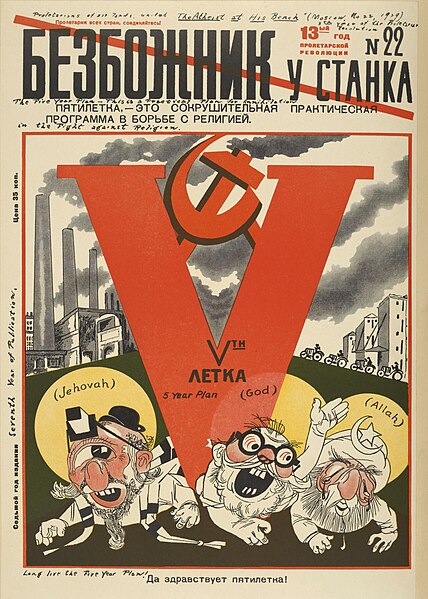USSR anti-religious campaign (1928–1941)
The USSR anti-religious campaign of 1928–1941 was a new phase of anti-religious campaign in the Soviet Union following the anti-religious campaign of 1921–1928. The campaign began in 1929, with the drafting of new legislation that severely prohibited religious activities and called for an education process on religion in order to further disseminate atheism and materialist philosophy. This had been preceded in 1928 at the fifteenth Party congress, where Joseph Stalin criticized the party for failure to produce more active and persuasive anti-religious propaganda. This new phase coincided with the beginning of the mass collectivization of agriculture and the nationalization of the few remaining private enterprises.
"Monks - the bloody enemies of the working people" (Banner on the Dormition Cathedral of the Kiev Cave Monastery, 1930s.)
Cover of Bezbozhnik u Stanka in 1929, magazine of the Society of the Godless. The first five-year plan of the Soviet Union is shown crushing the gods of the Abrahamic religions.
USSR anti-religious campaign (1921–1928)
The USSR anti-religious campaign (1921–1928) was a campaign of anti-religious persecution against churches and Christian believers by the Soviet government following the initial anti-religious campaign during the Russian Civil War. The elimination of all religion and its replacement with scientific materialism was a fundamental ideological goal of the state. To this end, the state began offering secular education to believers, intending to reduce the prevalence of superstition. It was never made illegal to be a believer or to have religion, and so the activities of this campaign were often veiled under other pretexts that the state invoked or invented in order to justify its activities.
In the late 1920s, St Volodymyr's Cathedral in Kyiv was used as an anti-religious museum.
Russian Orthodox metropolitan Benjamin (Kazansky) facing charges by Revolutionary Tribunal of Petrograd for Counter-Revolutionary Agitation (details)
Confiscation of church property in Petrograd, by Ivan Vladimirov





